
by Mark Tancig | Nov 16, 2016
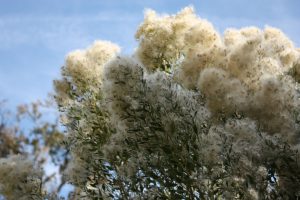
Female saltbush plant in bloom. Credit: Niels Proctor, hort.ifas.ufl.edu
If you have noticed bursts of white-flowered shrubs along roadsides, trails, and other natural areas the last couple of weeks, there’s a good chance that it was saltbush (Baccharis halimifolia). Saltbush is a native shrub in the sunflower or daisy family (Asteraceae) that can be found throughout the Coastal Plain. It often grows along the edges of freshwater and brackish water wetlands, but also seems happy in upland sites as well. It prefers sunny sites and can reach a height of ten to fifteen feet. There are separate female and male plants of this species, with females having the showy, white blooms while males are somewhat plain.
While it can be quite common in natural areas, it is rarely seen in the home landscape. Although saltbush is a somewhat leggy shrub, its home landscape value comes from the fact that it blooms at a time when most other plants are done blooming or are going into dormancy. In addition to its show of white flowers at a time when many other landscape plants are becoming drab, saltbush is also an important nectar source for migrating monarch butterflies. It is also tolerant of salt spray, so makes a good addition to the landscape in coastal areas.
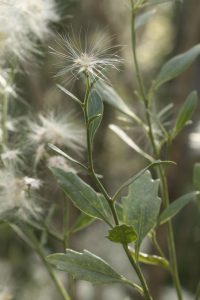
Leaves and seed of saltbush. Credit: Niels Proctor, hort.ifas.ufl.edu
Saltbush may be hard to find in the retail nursery trade, but can often be sourced from nurseries that specialize in native plants or ecosystem restoration plantings. There are male and female plants, so when purchasing, you may want to see it in bloom to verify that you picked a female. If you know someone with saltbush on their property, you can start some on your own by collecting seed or propagating it through soft or hardwood cuttings.
If you would like to try out an underused, native shrub that provides great late fall color and helps feed monarch butterflies for their journey home, plant a saltbush in your landscape. You may have neighbors asking about that unusual, but pretty, shrub.
More information can be found at Baccharis halimifolia Salt Bush, Groundsel Bush
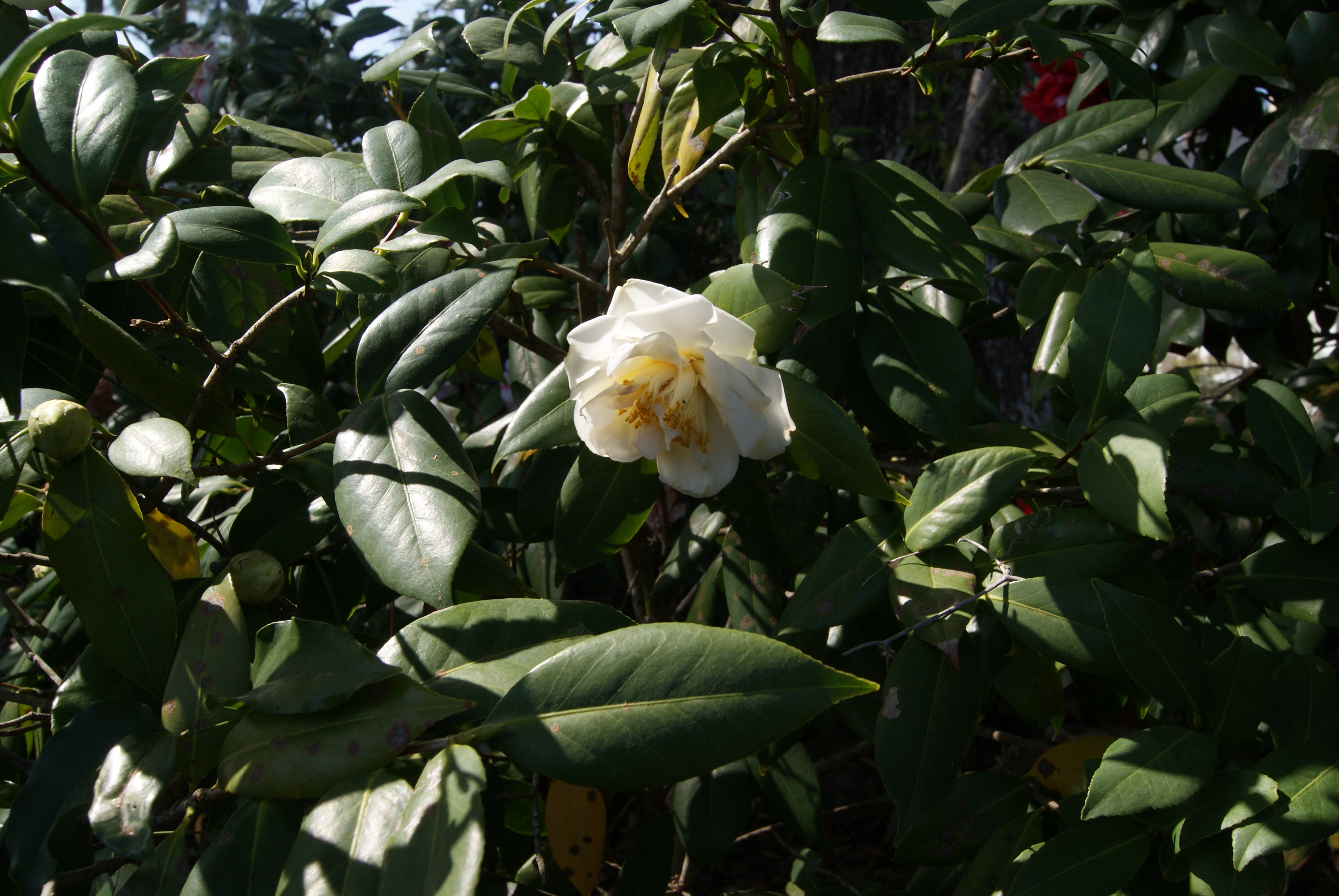
by Blake Thaxton | Nov 3, 2016
It was a hot summer that has continued into Fall. We hope cooler temperatures are on their way to the panhandle of Florida. Fall can be a great time to spruce up your landscape with some new shrubs.
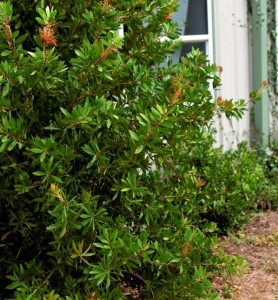
Image Credit UF / IFAS
It may be time for your landscape to receive a mini-makeover and to get a new look. Perhaps some strategically placed shrubs will be what makes an outdoor living space pop. Proper selection and installation is key to future health of new shrubs.
Selection
There are several factors that need to be considered before installing new shrubs to the landscape. Selecting plants carefully, based on the following points, will help with long-term success of the plant:
- Climate – Be sure that the species are climate appropriate.
- Environment – Study the light level, acidity, and drainage of the planting site.
- Space – Account for the mature size of the plant before planting. This will eliminate the possible need for plant removal if space is not adequate.
- Inspect the plant – Check for mechanical injury (scars and open wounds), cold injury, condition and shape of the canopy, and examine the root system.
Installation
Now that essential considerations have been made, it is time to give the shrub the best chance for survival with proper installation techniques. Fall and winter is an ideal time for planting shrubs. The roots can develop before the tops begin to grow in spring. The following are keys to proper establishment of container shrubs.
- Root ball preparation – Remove the container from the root ball and inspect for circling roots. If there are circling roots than make three or four cuts vertically to cut the roots. Pull some of the roots away so they will take on a new growth direction (massage the roots). Also find the top most roots, as sometimes they are covered by extra potting media. Remove the extra potting media so the top most roots are exposed and become the top of the root ball.
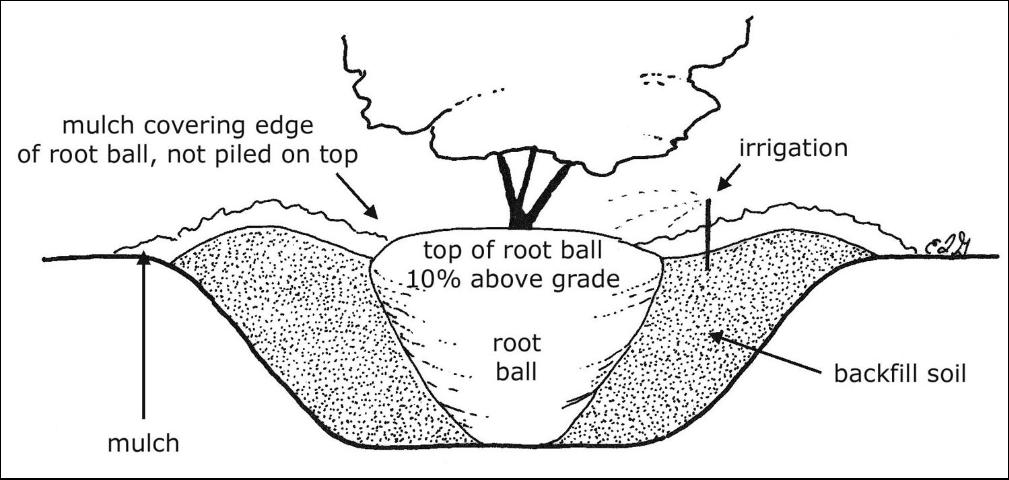
Image Credits: UF/IFAS, Edward F. Gilman
- Wider is better – Dig the hole two or three times the diameter of the root ball.
- Proper depth – Make sure to dig the hole 10% less than the height of the root ball. In poorly drained soils dig the hole 25% less than the height of the root ball. The top most roots should be slightly above the native soils.
- Backfill – Fill the hole with existing soil half way and tamp the soil to settle. Again fill the rest of the hole with the existing soil and tamp again to settle the soil. Do not place any backfill soil or mulch over the root ball as it is crucial that water and air are able to be in contact with the roots.
- Aftercare – Irrigate daily for the first two weeks, followed by every other day for the next two months, and weekly until the shrub is established (For <2 inch caliper shrubs).
If these key points are followed regarding selection and installation, the shrubs will be well on their way to becoming established in the landscape. If you would like read more in detail about installation please read the following:
Specifications for Planting Trees and Shrubs in the Southeastern U.S.
Literature:
Gilman, E.F., (2011, August) Specifications for Planting Trees and Shrubs in the Southeastern U.S.. Retrieved from: http://edis.ifas.ufl.edu/ep112
Black, R.J. and Ruppert, K.C., (1998) Your Florida Landscape, A complete guide to planting & maintenance. Gainesville, FL: University Press of Florida.






